Flexural Behavior of a Precast Concrete Deck Connected with Headed GFRP Rebars and UHPC
Abstract
1. Introduction
1.1. General
1.2. Manufacturing of a GFRP Rebar
1.3. Concrete Headed GFRP Rebar
2. Experimental Program
2.1. Pull-out Test of GFRP Rebars
2.1.1. Material Properties and Test Specimens
2.1.2. Testing Method and Setup
2.2. Flexural Test of a Connected Precast Concrete Deck
2.2.1. Material Properties and Test Specimens
2.2.2. Testing Method and Setup
3. Test Results
3.1. Pull-Out Properties of GFRP Rebars
3.2. Flexural Strength of Connected Precast Concrete Deck
4. Conclusions
- In this study, two types of headed GFRP rebars were developed and tested, and their basic pull-out mechanical properties were evaluated. Additionally, by conducting the flexural test on the connected precast concrete deck, the practical effectiveness of the headed GFRP rebar was confirmed.
- The pull-out test results confirmed the tendency of rebars with larger diameters to have a lower failure strength. In particular, it is important to note that the specimen made with UHPC exhibited a significantly higher failure load in comparison with the other specimens. Consequently, improved structural performance can be expected when UHPC is used as the filler material at the connection between precast deck slabs.
- The length of the connection in the precast concrete deck can be decreased with the use of headed GFRP rebars. The flexural test results verified that the headed GFRP rebars can provide effective anchorage performance. The LC and CH types did not exhibit significant differences in the structural performance at the connection zone of the precast decks. It is interesting to note that all the specimens using UHPC exhibited excellent flexural performance.
Author Contributions
Funding
Conflicts of Interest
References
- You, Y.-J.; Kim, J.-H.J.; Park, Y.-H.; Choi, J.-H. Fatigue Performance of Bridge Deck Reinforced with Cost-to-Performance Optimized GFRP rebar with 900 MPa Guaranteed Tensile Strength. J. Adv. Concr. Technol. 2015, 13, 252–262. [Google Scholar] [CrossRef]
- Benmokrane, B.; Mohamed, H.M.; Manalo, A.; Cousin, P. Evaluation of Physical and Durability Characteristics of New Headed Glass Fiber–Reinforced Polymer Bars for Concrete Structures. J. Compos. Constr. 2017, 21, 04016081. [Google Scholar] [CrossRef]
- Okelo, R.; Yuan, R.L. Bond Strength of Fiber Reinforced Polymer Rebars in Normal Strength Concrete. J. Compos. Constr. 2005, 9, 203–213. [Google Scholar] [CrossRef]
- Cho, J.-R.; Park, Y.-H.; Park, S.-Y.; Kim, S.-T. Pullout behavior of concrete-headed GFRP rebars. In Proceedings of the ASEM17, the 2017 World Congress, Seoul, Korea, 28 August–1 September 2017. [Google Scholar]
- Hao, Q.; Wang, Y.; He, Z.; Ou, J. Bond strength of glass fiber reinforced polymer ribbed rebars in normal strength concrete. Constr. Build. Mater. 2009, 23, 865–871. [Google Scholar] [CrossRef]
- Committee ACI 440. Guide for the Design and Construction of Concrete Reinforced with FRP Bars (ACI 440.1 R-06); American Concrete Institute: Detroit, MI, USA, 2006. [Google Scholar]
- American Society for Testing and Materials. ASTM C39: Standard Test Method for Compressive Strength of Cylindrical Concrete Specimens; ASTM International: West Conshohocken, PA, USA, 2012. [Google Scholar]
- Zadeh, H.J.; Nanni, A. Design of RC Columns Using Glass FRP Reinforcement. J. Compos. Constr. 2013, 17, 294–304. [Google Scholar] [CrossRef]
- Porter, S.D.; Julander, J.L.; Halling, M.W.; Barr, P.J.; Boyle, H.; Xing, S. Flexural Testing of Precast Bridge Deck Panel Connections. J. Bridg. Eng. 2011, 16, 422–430. [Google Scholar] [CrossRef]
- Maranan, G.; Manalo, A.; Karunasena, W.M.; Benmokrane, B. Pullout behaviour of GFRP bars with anchor head in geopolymer concrete. Compos. Struct. 2015, 132, 1–25. [Google Scholar] [CrossRef]
- AASHTO. Bridge Design Guide Specifications for GFRP—Reinforced Concrete Bridge Decks and Traffic Railings; American Association of State Highway and Transportation Officials: Washington, DC, USA, 2009. [Google Scholar]
- Korea Concrete Institute. Design Guideline of FRP-Reinforced Concrete Structures; Korea Concrete Institute: Seoul, Korea, 2019. [Google Scholar]
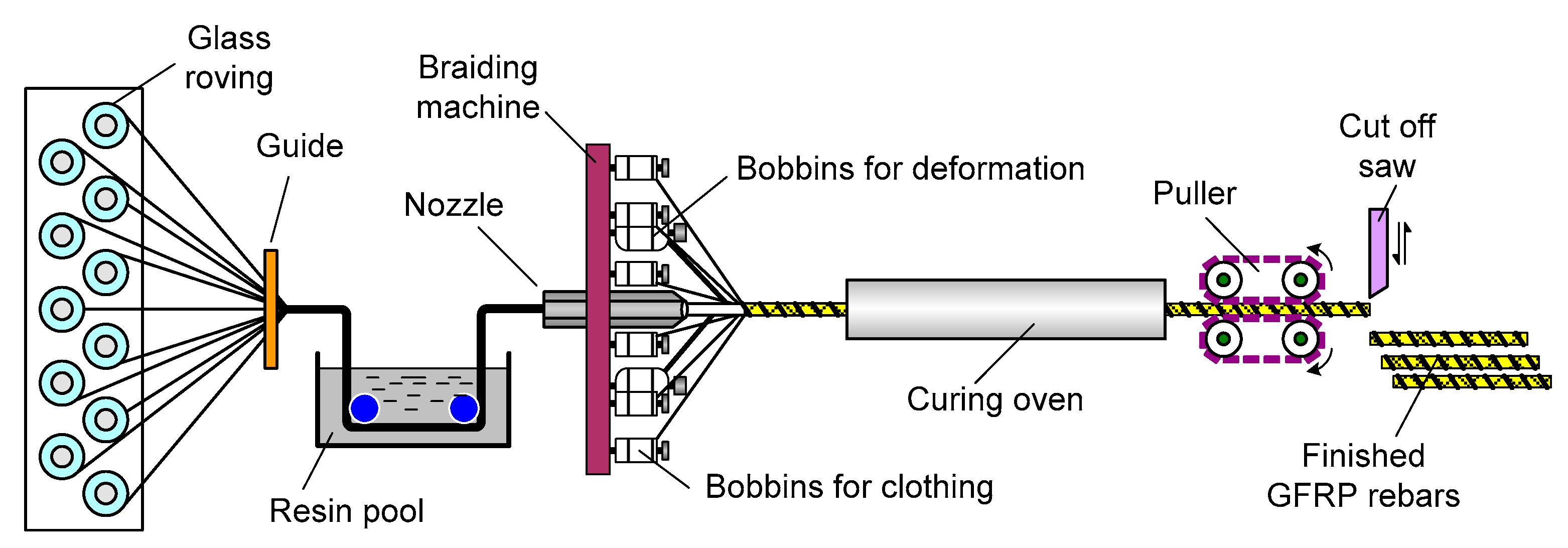
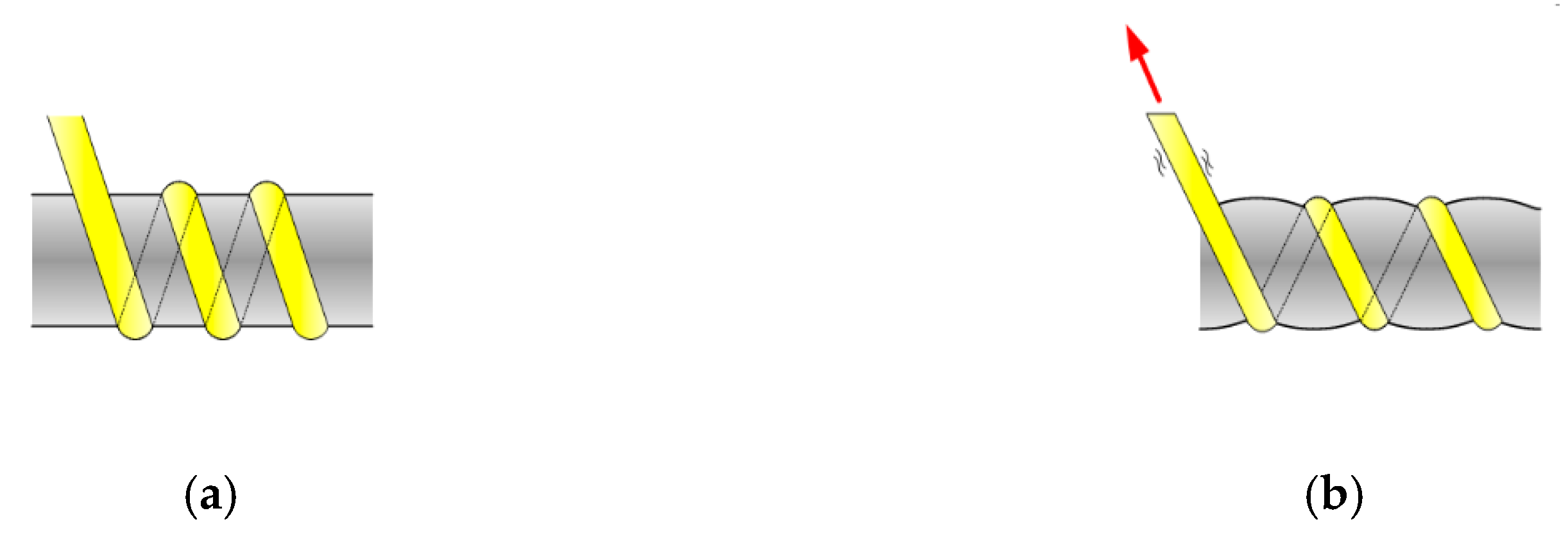
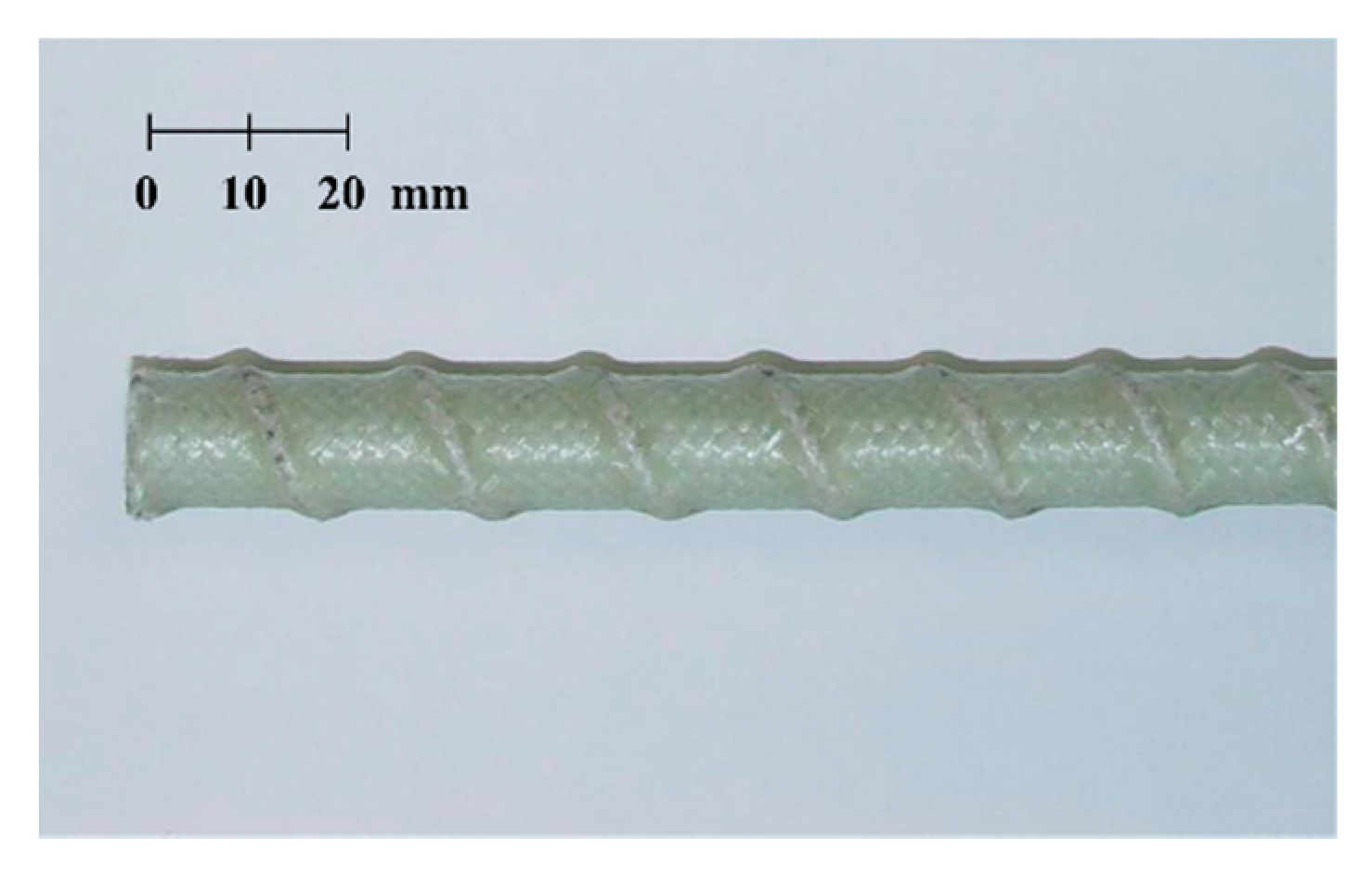
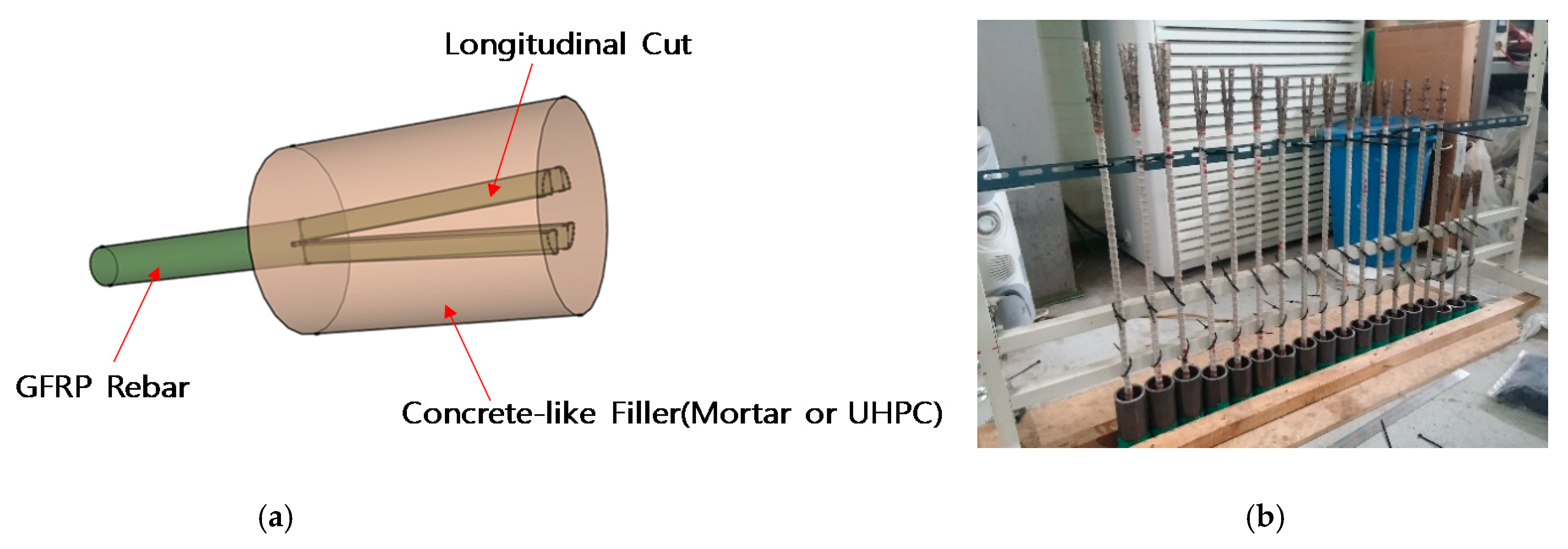
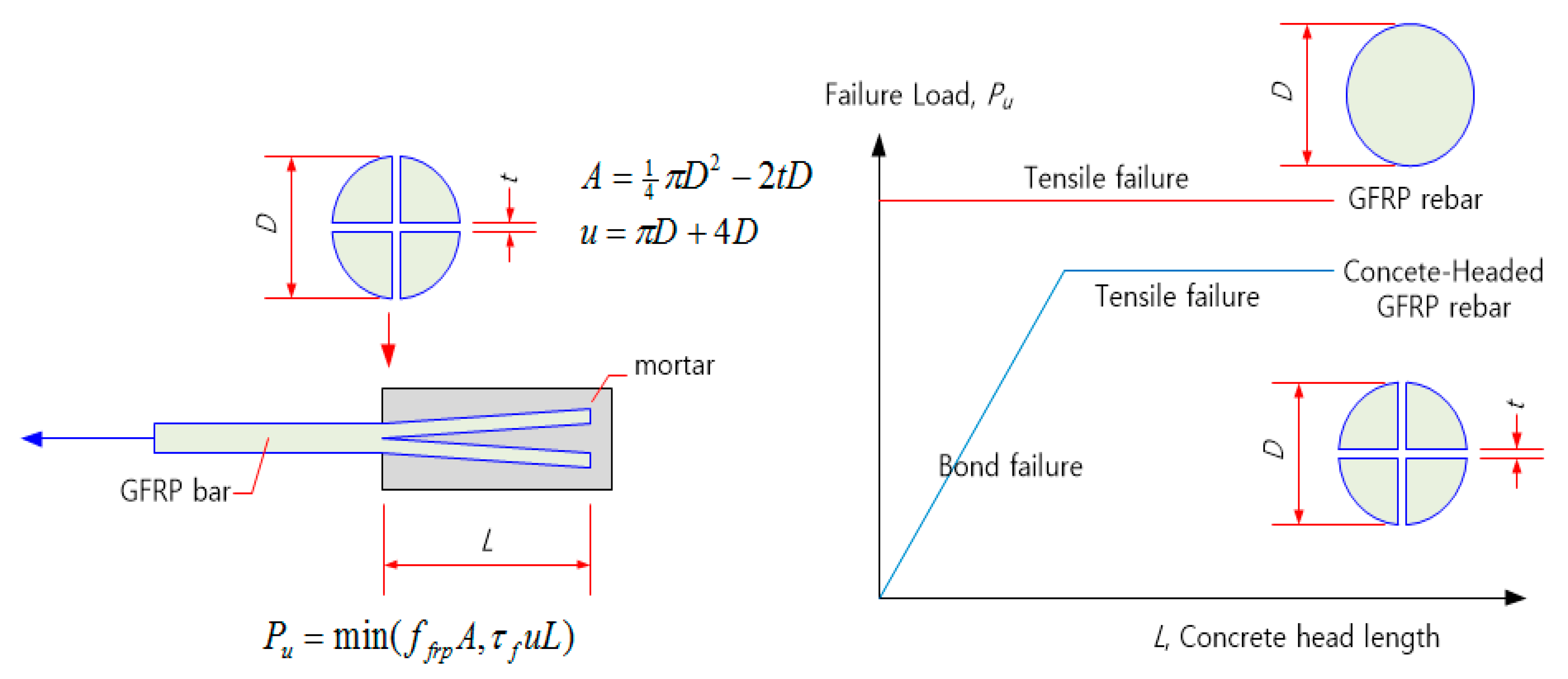
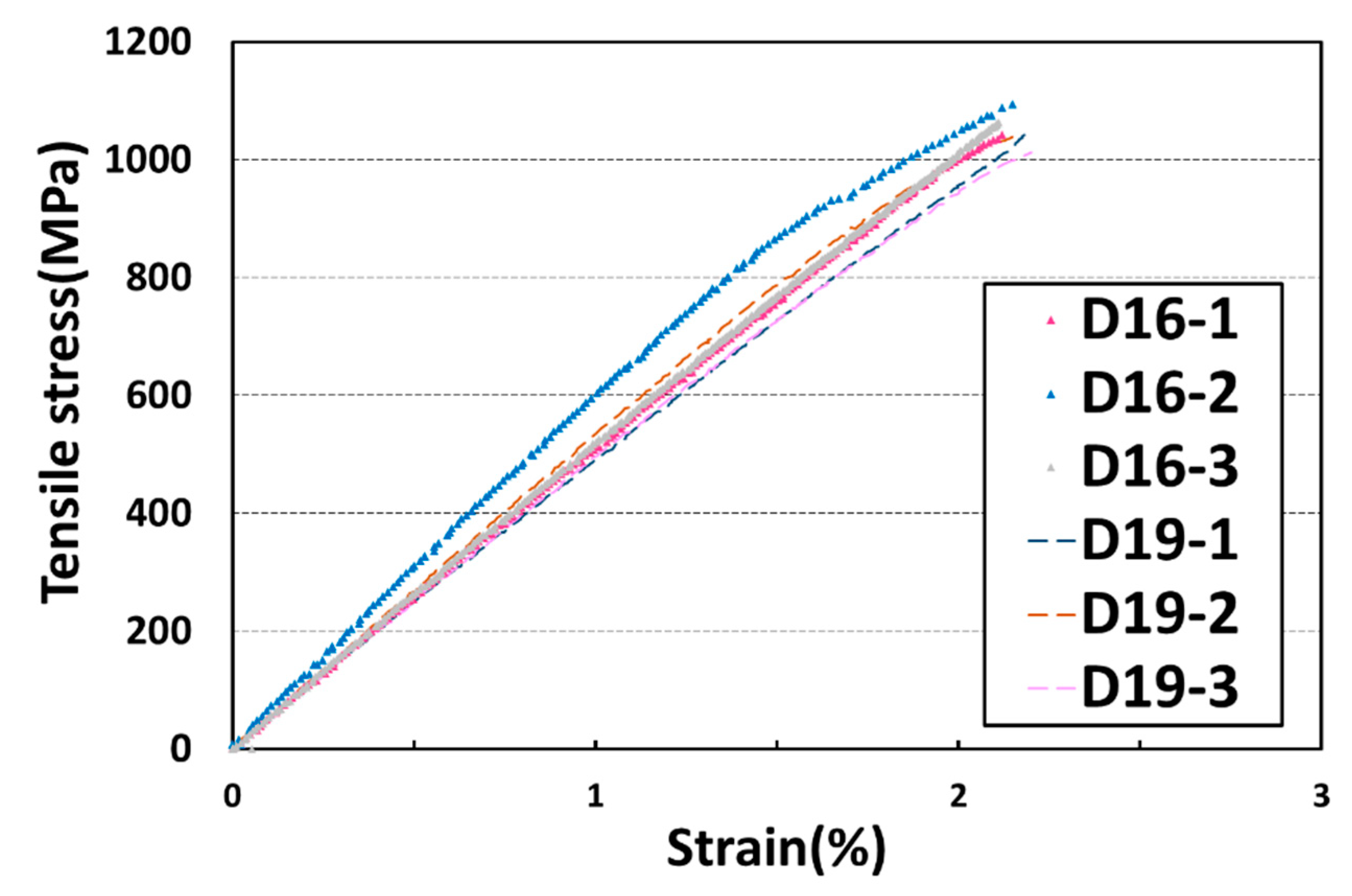
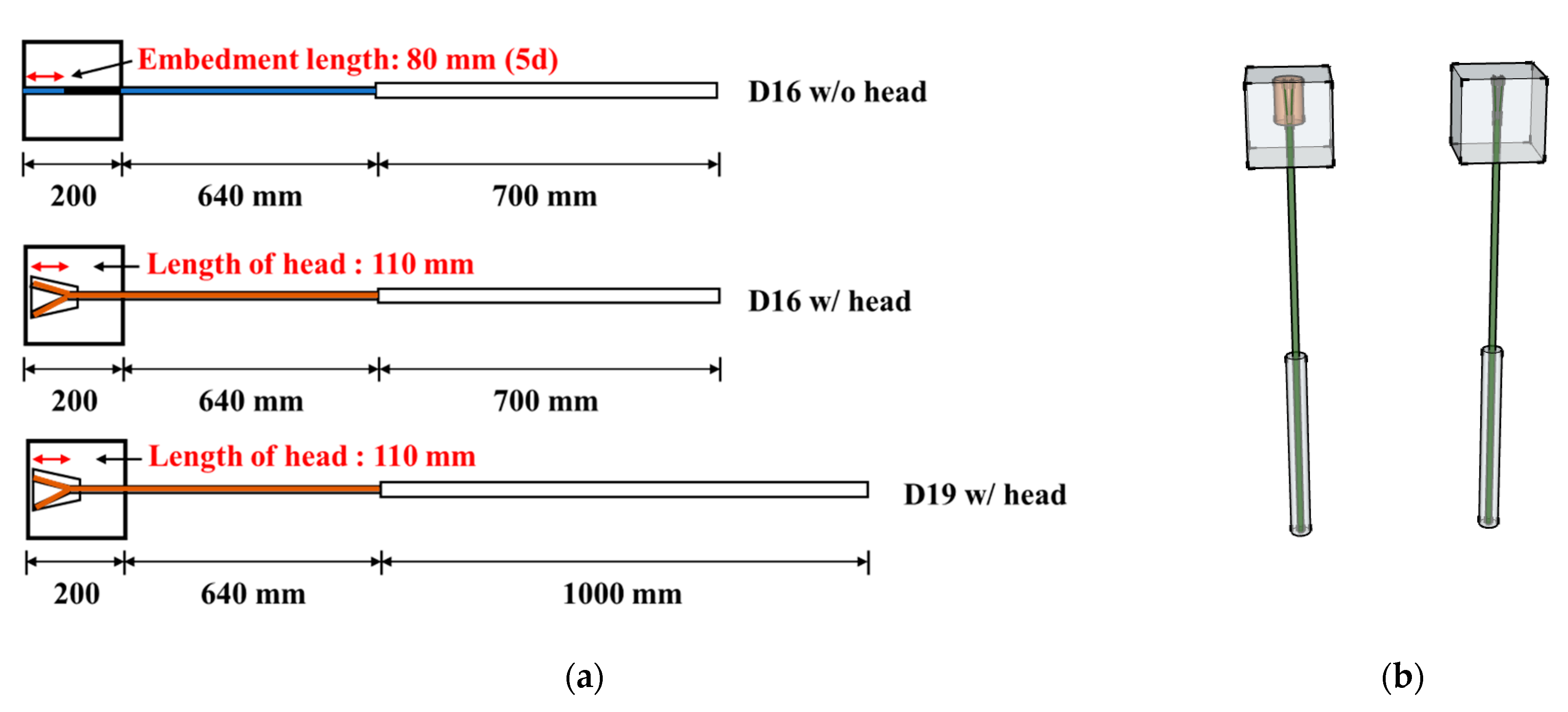


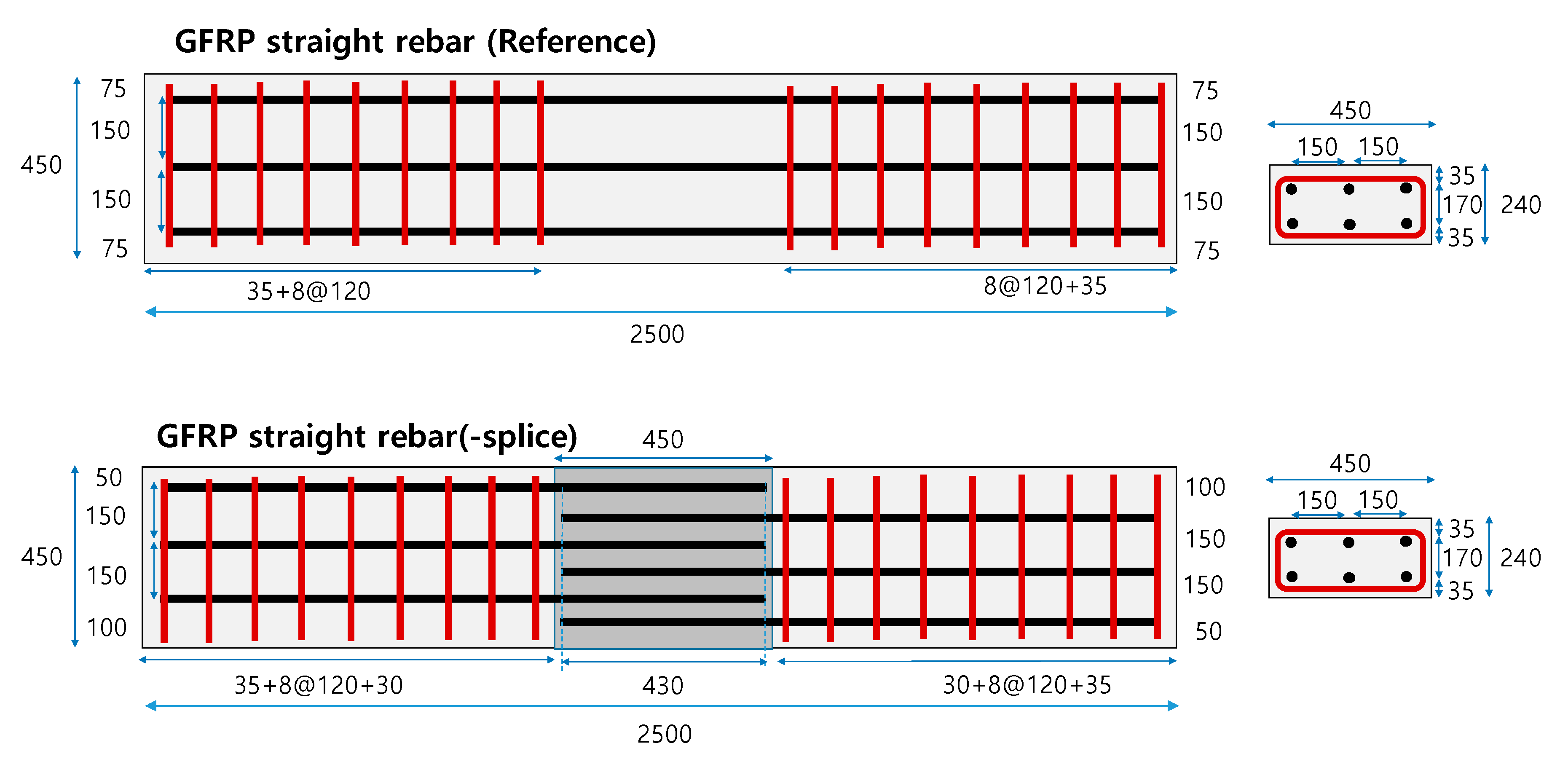
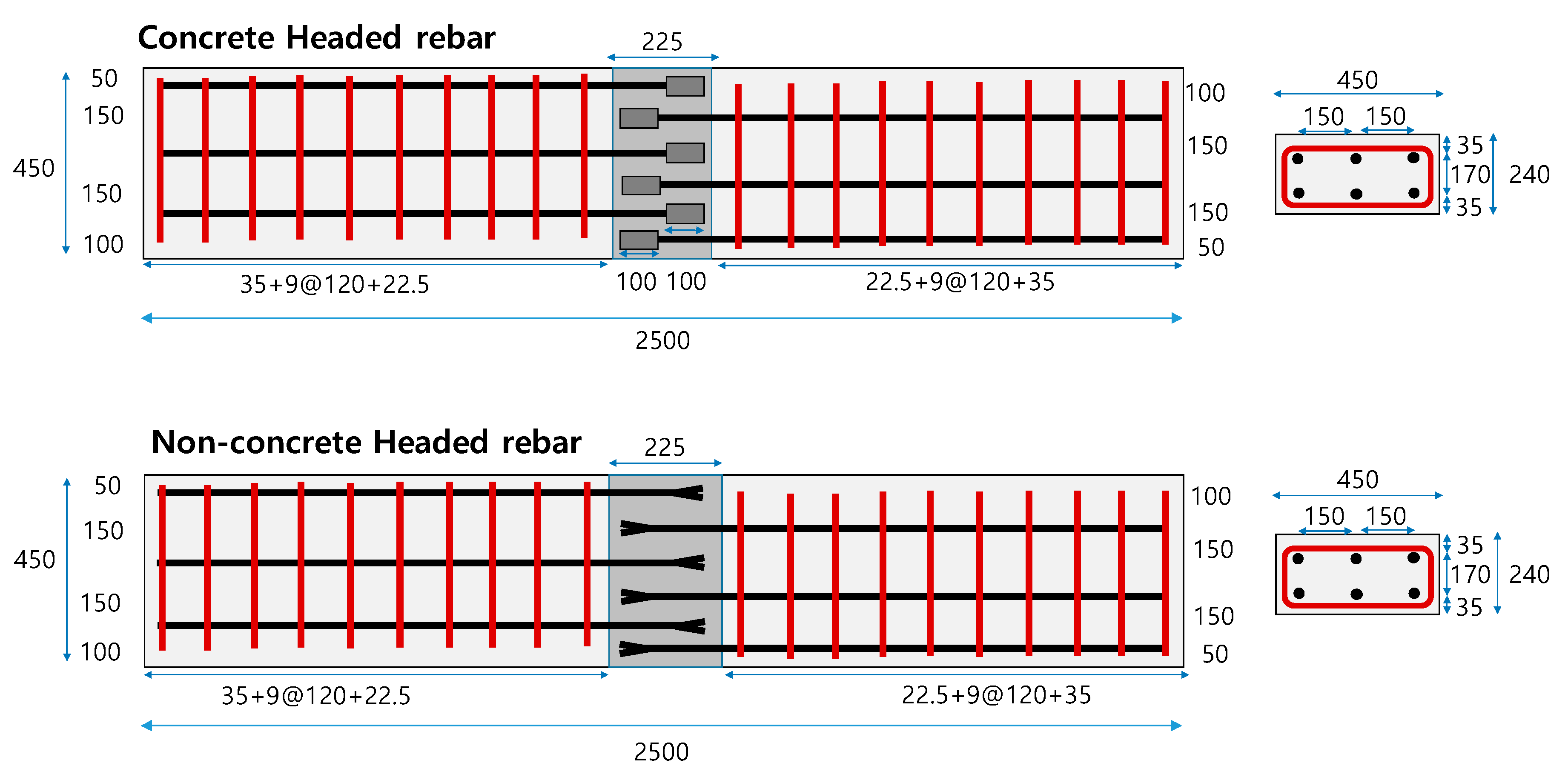
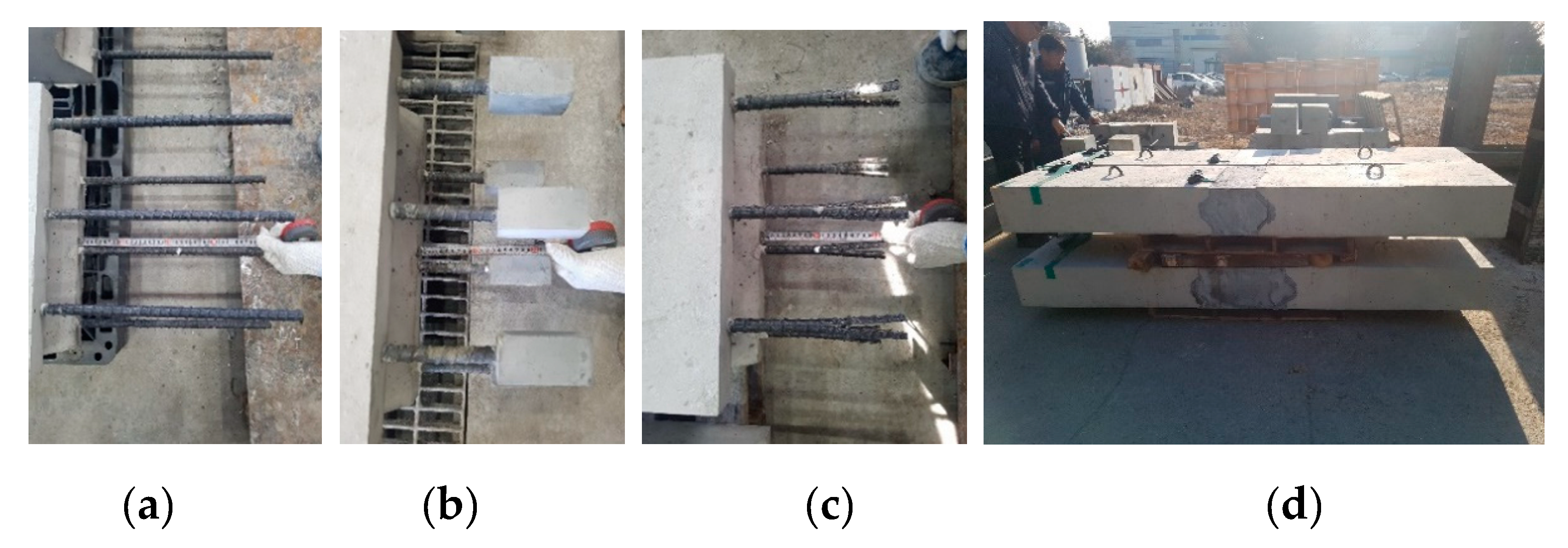

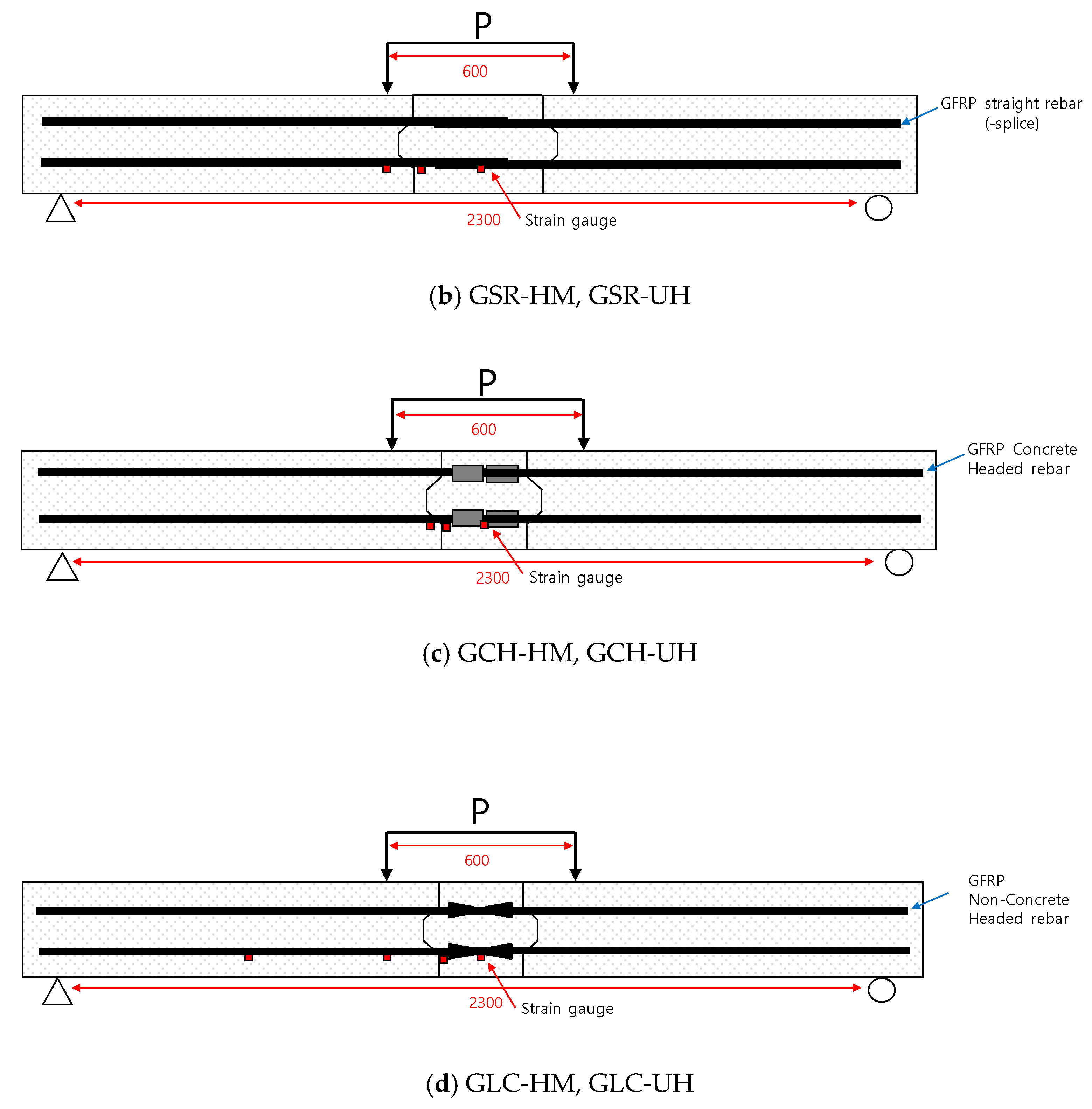
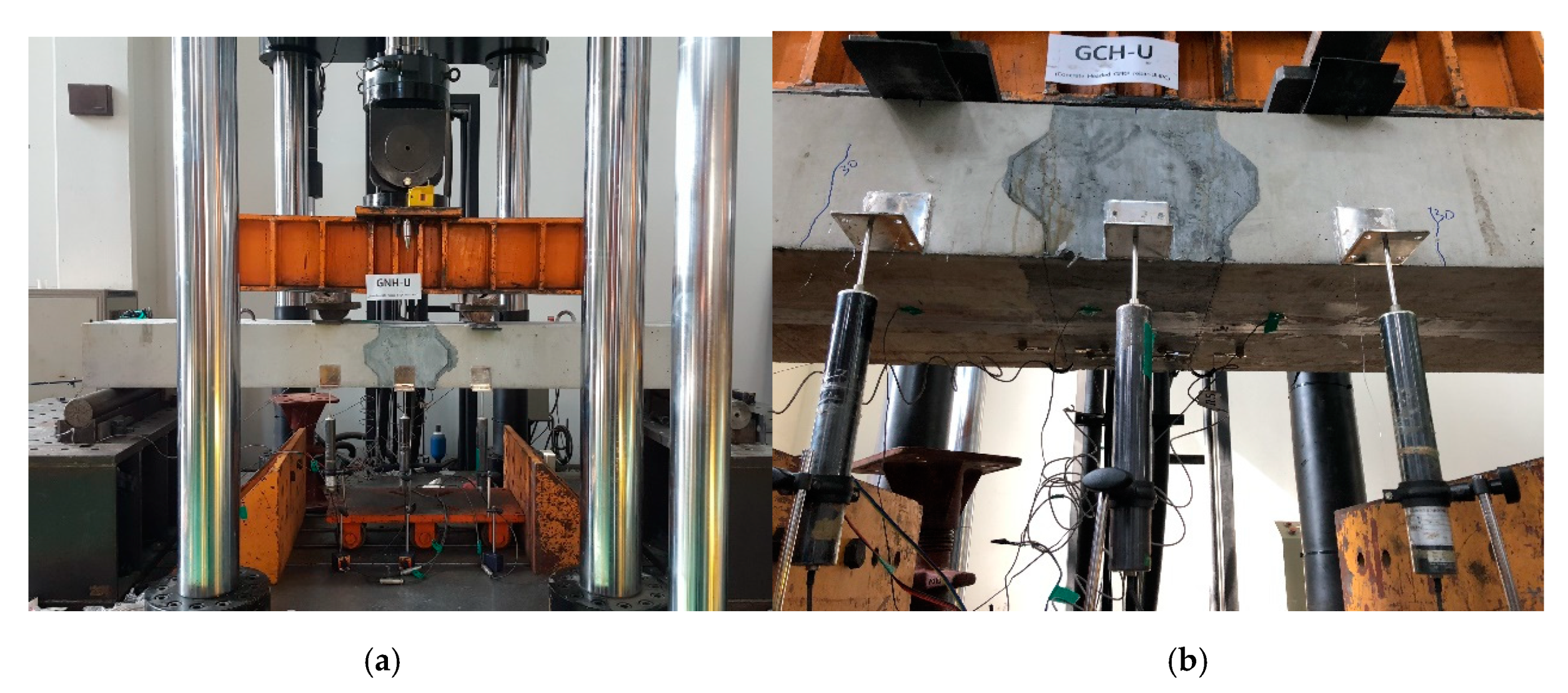
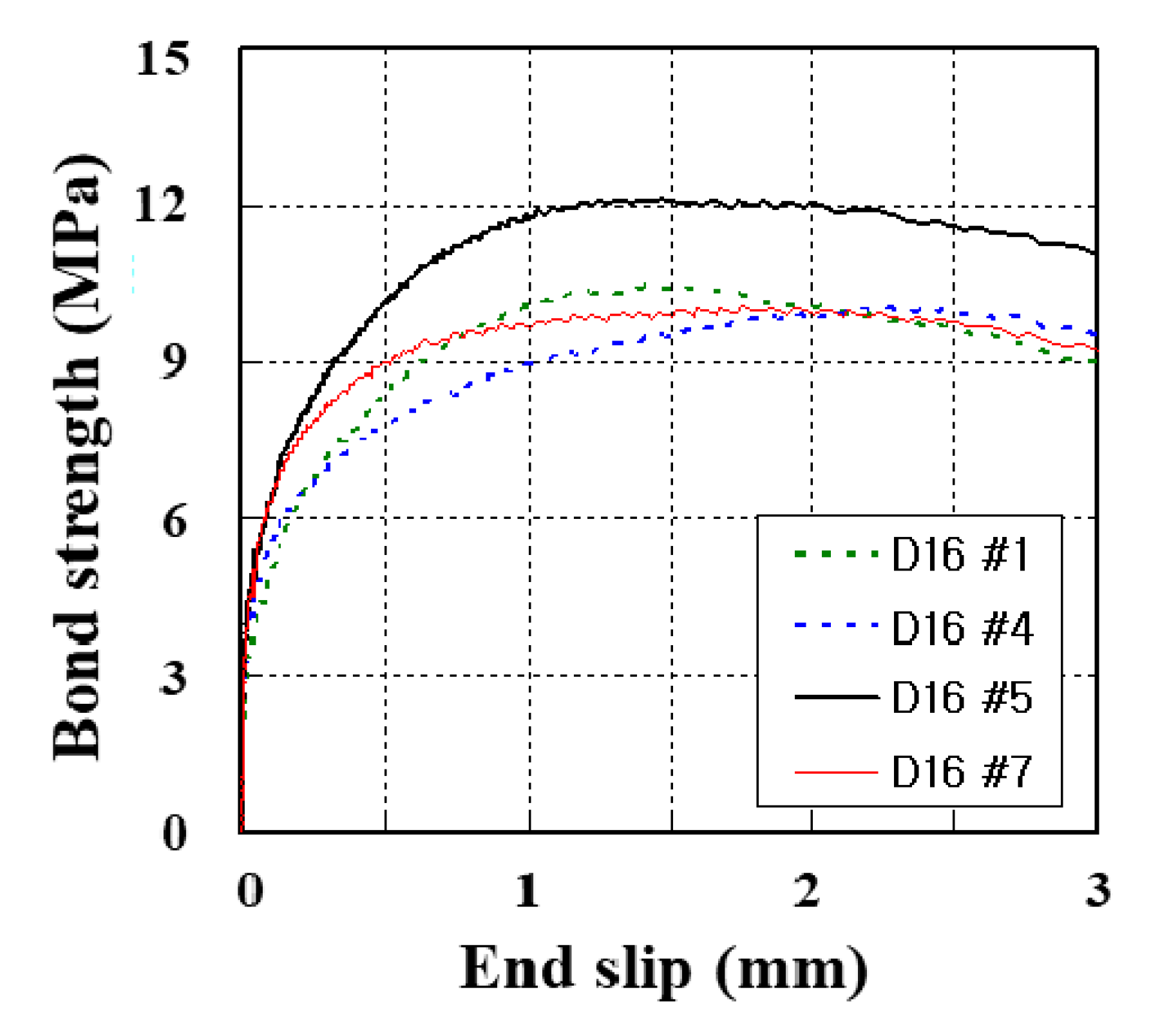
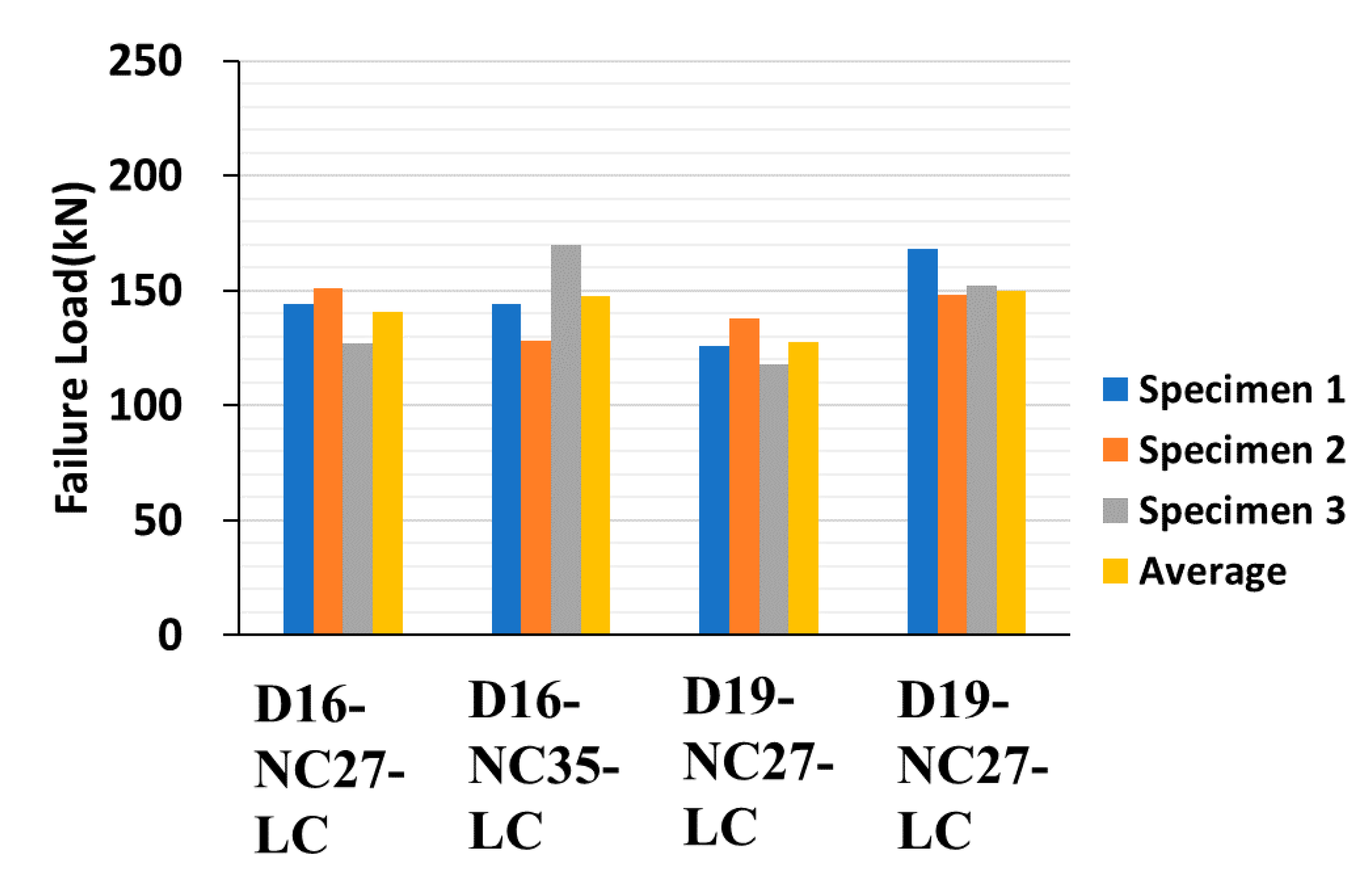
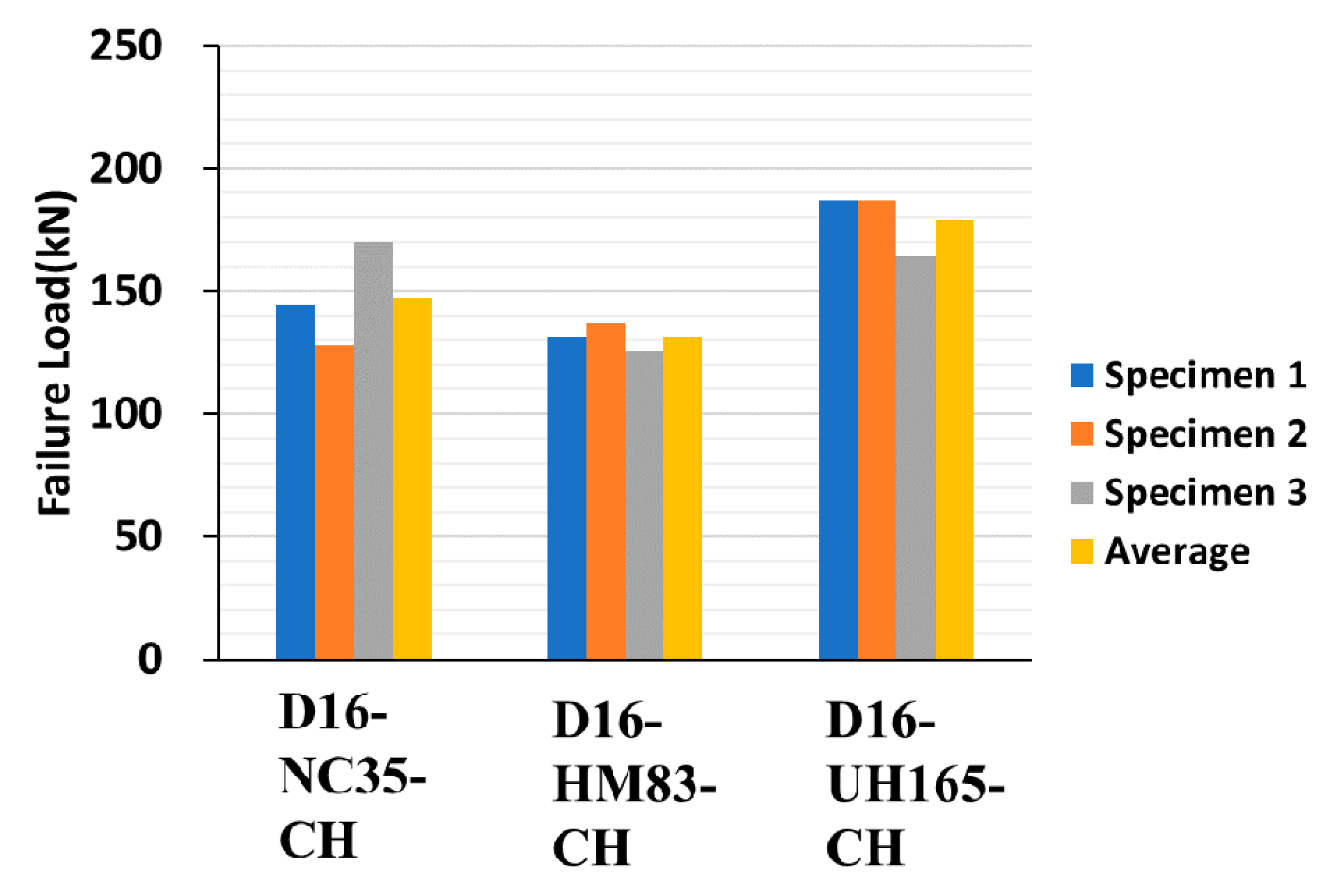


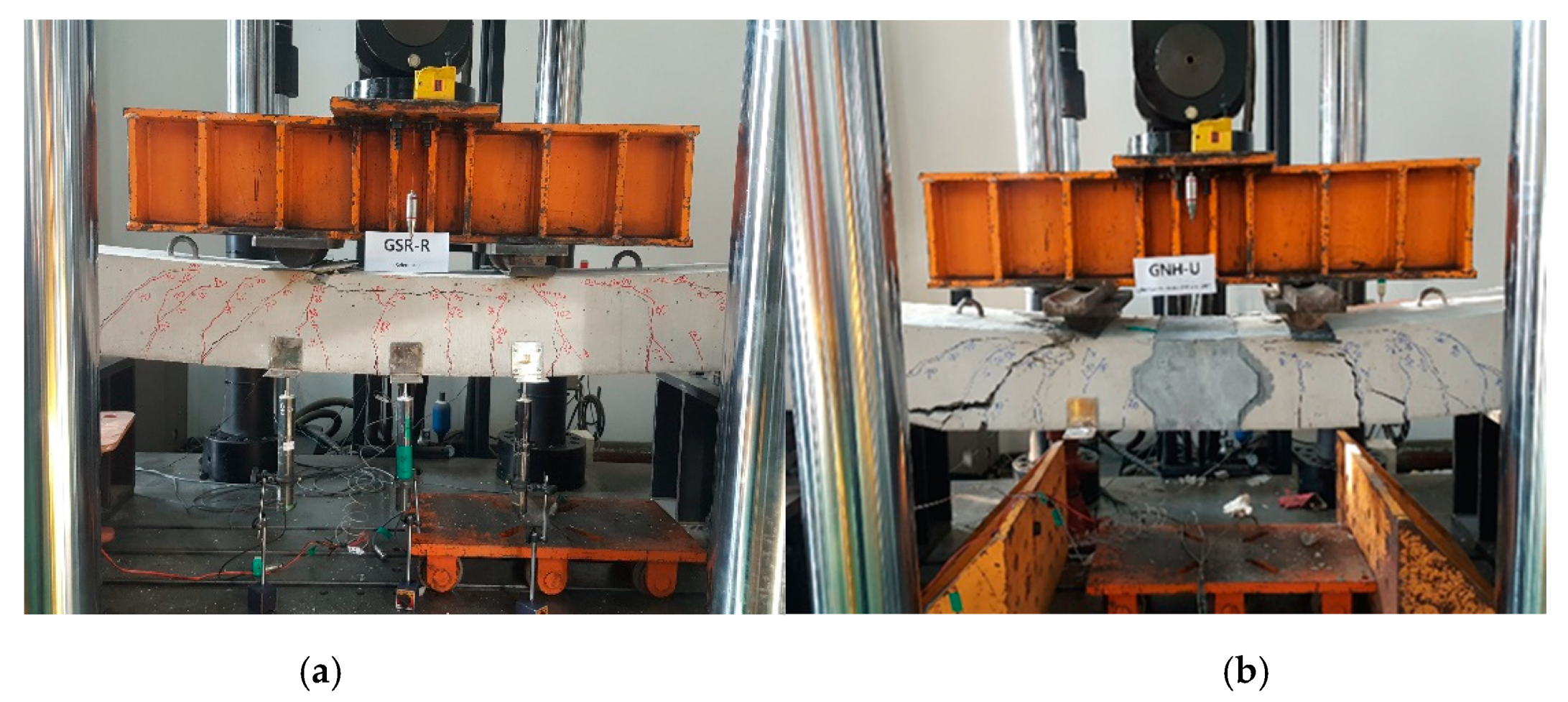
| Notation | d (mm) | C | fck (MPa) | Type of Head | No. of Specimens |
|---|---|---|---|---|---|
| D16-NC35-N | 16 | NC | 35.0 | W/O head | 10 |
| D16-NC27-LC | 16 | NC | 27.0 | LC | 4 |
| D16-NC35-LC | NC | 35.0 | 4 | ||
| D19-NC27-LC | 19 | NC | 27.0 | 4 | |
| D19-NC35-LC | NC | 35.0 | 4 | ||
| D16-NC35-CH | 16 | NC | 35.0 | CH | 3 |
| D16-HM83-CH | HM | 83.2 | 3 | ||
| D16-UH165-CH | UH | 165.6 | 3 | ||
| D19-NC35-CH | 19 | NC | 35.0 | 3 | |
| D19-HM83-CH | HM | 83.2 | 3 | ||
| D19-UH165-CH | UH | 165.6 | 3 |
| Tensile Properties | D16 | D19 |
|---|---|---|
| Maximum tensile strength, , MPa | 1066.39 | 1030.38 |
| Nominal tensile strength, , MPa | 987.55 | 981.38 |
| Design tensile strength, , MPa | 691.28 | 686.97 |
| Elastic modulus, , GPa | 47.84 | 46.71 |
| Variables | W/B (%) | Unit Weight (kg/m3) | ||||||
|---|---|---|---|---|---|---|---|---|
| W | C | FA | CA | AD | Steel Fiber | SP (g) | ||
| NC | 40.0 | 226 | 562 | 598 | 786 | 0 | 0 | - |
| HM | 42.5 | 170 | 200 | 1640 * | 0 | 200 (Fly ash) | 0 | 5.25 |
| UHPC | 20.0 | 183 | 799.5 | 880 | 0 | 84 (Silica fume) | 78 (19.5 mm) 39 (16.3 mm) | 18.4 |
| Specimen | Connection Joint | Connection Joint Length | Filler |
|---|---|---|---|
| GSR-R | None | Reference | Reference |
| GSR-HM | Spliced straight GFRP rebar | 450 mm | 83 MPa Mortar |
| GSR-UH | Spliced straight GFRP rebar | 450 mm | 165 MPa UHPC |
| GCH-HM | Concrete Headed GRFP rebar | 225 mm | 83 MPa Mortar |
| GCH-UH | Concrete Headed GRFP rebar | 225 mm | 165 MPa UHPC |
| GLC-HM | Non-concrete Headed GRFP rebar | 225 mm | 83 MPa Mortar |
| GLC-UH | Non-concrete Headed GRFP rebar | 225 mm | 165 MPa UHPC |
| Specimens | Max. Load (kN) | Bond Strength (MPa) | End Slip (mm) | Failure Mode |
|---|---|---|---|---|
| D16-1 | 41.92 | 10.42 | 1.410 | pullout |
| D16-2 | 42.71 | 10.62 | 1.335 | pullout |
| D16-3 | 41.91 | 10.42 | 1.840 | pullout |
| D16-4 | 40.49 | 10.07 | 2.265 | pullout |
| D16-5 | 48.78 | 12.13 | 1.465 | pullout |
| D16-6 | 40.46 | 10.06 | 2.305 | pullout |
| D16-7d | 40.45 | 10.06 | 1.755 | pullout |
| D16-8 | 45.59 | 11.34 | 1.420 | pullout |
| D16-9 | 45.36 | 11.28 | 1.410 | pullout |
| D16-10 | 48.19 | 11.98 | 1.365 | pullout |
| Ave. | 43.58 | 10.84 | 1.66 | - |
| STDEV | 3.18 | 0.79 | 0.37 | - |
| C.O.V. | 7.3% | 7.3% | 22.3% | - |
| Specimen | No. | Pull Out Displacement (mm) | Max. Load (kN) |
|---|---|---|---|
| D16-NC27-CH | 1 | 632 | 144 |
| 2 | 644 | 151 | |
| 3 | 643 | 127 | |
| D16-NC35-CH | 1 | 534 | 144 |
| 2 | 639 | 128 | |
| 3 | 636 | 170 | |
| D16-HM83-CH | 1 | 651 | 131 |
| 2 | 654 | 137 | |
| 3 | 659 | 126 | |
| D16-UH165-CH | 1 | 657 | 187 |
| 2 | 656 | 187 | |
| 3 | 665 | 164 | |
| D19-NC27-CH | 1 | 755 | 126 |
| 2 | 753 | 138 | |
| 3 | 752 | 118 | |
| D19-NC35-CH | 1 | 758 | 168 * |
| 2 | 754 | 148 | |
| 3 | 754 | 152 | |
| D19-HM83-CH | 1 | 778 | 150 |
| 2 | 778 | 135 | |
| 3 | 778 | 123 * | |
| D19-UH165-CH | 1 | 774 | 219 |
| 2 | 778 | 215 | |
| 3 | 777 | 226 |
© 2020 by the authors. Licensee MDPI, Basel, Switzerland. This article is an open access article distributed under the terms and conditions of the Creative Commons Attribution (CC BY) license (http://creativecommons.org/licenses/by/4.0/).
Share and Cite
Chin, W.J.; Park, Y.H.; Cho, J.-R.; Lee, J.-Y.; Yoon, Y.-S. Flexural Behavior of a Precast Concrete Deck Connected with Headed GFRP Rebars and UHPC. Materials 2020, 13, 604. https://doi.org/10.3390/ma13030604
Chin WJ, Park YH, Cho J-R, Lee J-Y, Yoon Y-S. Flexural Behavior of a Precast Concrete Deck Connected with Headed GFRP Rebars and UHPC. Materials. 2020; 13(3):604. https://doi.org/10.3390/ma13030604
Chicago/Turabian StyleChin, Won Jong, Young Hwan Park, Jeong-Rae Cho, Jin-Young Lee, and Young-Soo Yoon. 2020. "Flexural Behavior of a Precast Concrete Deck Connected with Headed GFRP Rebars and UHPC" Materials 13, no. 3: 604. https://doi.org/10.3390/ma13030604
APA StyleChin, W. J., Park, Y. H., Cho, J.-R., Lee, J.-Y., & Yoon, Y.-S. (2020). Flexural Behavior of a Precast Concrete Deck Connected with Headed GFRP Rebars and UHPC. Materials, 13(3), 604. https://doi.org/10.3390/ma13030604






